初三英语被动语态
九年级被动语态语法知识点

九年级被动语态语法知识点被动语态是英语语法中的一个重要部分,它用来描述句子的主语是被动者,而动作的执行者则成为句子的宾语。
在九年级的英语学习中,学生将接触到被动语态的相关知识点。
本文将为大家介绍九年级被动语态的三个主要知识点。
知识点一:被动语态的构成被动语态的构成由be动词的不同形式加上过去分词组成。
根据每个时态的规则,我们可以将被动语态的构成进行总结。
1. 一般现在时的被动语态:am/is/are + 过去分词例:Active: The teacher explains the lesson.Passive: The lesson is explained by the teacher.2. 一般过去时的被动语态:was/were + 过去分词例:Active: They cleaned the classroom.Passive: The classroom was cleaned by them.3. 一般将来时的被动语态:will be + 过去分词例:Active: She will write a letter.Passive: A letter will be written by her.4. 现在进行时的被动语态:am/is/are + being + 过去分词例:Active: They are building a new house.Passive: A new house is being built by them.5. 过去进行时的被动语态:was/were + being + 过去分词例:Active: He was repairing his bike.Passive: His bike was being repaired by him.6. 现在完成时的被动语态:has/have been + 过去分词例:Active: She has written a book.Passive: A book has been written by her.知识点二:被动语态的用法被动语态在英语中有着重要的应用。
初三英语被动语态讲解

一、某些词用主动语态表示被动
3. 表示“开始,终止,移动,运转”的动词, begin, start, end, stop,move,drive 例句: 1. The meeting starts at nine.
二、有些词的被动语态+ to be done+ to do
make sb do sth ----- sb be made to do sth notice sb do sth ----- sb be noticed to do sth see sb do sth --------- sb be seen to do sth
使用正确语态形式填空
was killed 1. Dr. Martin Luther King_______ (kill). 2. The worlddown Trade Center was taken ______________(take down) by terrorists will in 2001. be sold 3. The pig ____________(sell) tomorrow.
4a Complete the sentences with the correct forms of the verbs in brackets.
are not allowed (not 1. Children under 18 _______________ allowed) to watch this show without their parents. are paid (pay) by the boss on the last 2. We _________ Friday of each month. is spoken (speak) in 3. A: What language ___________ Germany? B: Most people speak German, but many can speak English, too.
九年级英语被动语态
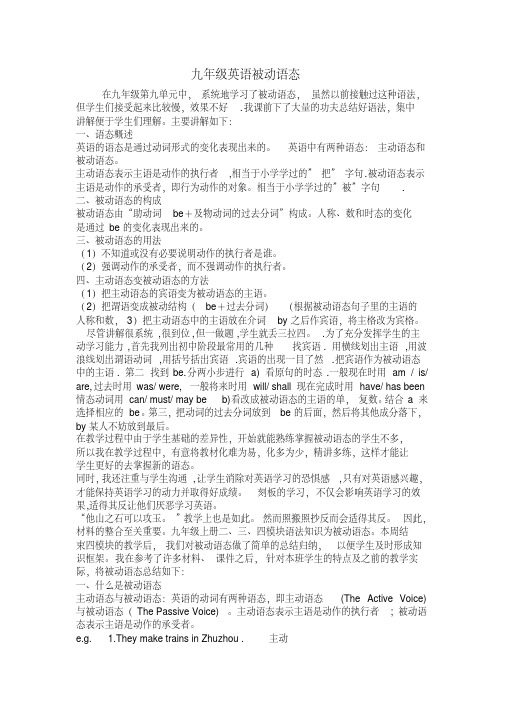
九年级英语被动语态在九年级第九单元中,系统地学习了被动语态,虽然以前接触过这种语法,但学生们接受起来比较慢,效果不好.我课前下了大量的功夫总结好语法,集中讲解便于学生们理解。
主要讲解如下:一、语态概述英语的语态是通过动词形式的变化表现出来的。
英语中有两种语态:主动语态和被动语态。
主动语态表示主语是动作的执行者,相当于小学学过的”把”字句.被动语态表示主语是动作的承受者,即行为动作的对象。
相当于小学学过的”被”字句.二、被动语态的构成被动语态由“助动词be+及物动词的过去分词”构成。
人称、数和时态的变化是通过be的变化表现出来的。
三、被动语态的用法(1)不知道或没有必要说明动作的执行者是谁。
(2)强调动作的承受者,而不强调动作的执行者。
四、主动语态变被动语态的方法(1)把主动语态的宾语变为被动语态的主语。
(2)把谓语变成被动结构(be+过去分词)(根据被动语态句子里的主语的人称和数,3)把主动语态中的主语放在介词by之后作宾语,将主格改为宾格。
尽管讲解很系统,很到位,但一做题,学生就丢三拉四。
.为了充分发挥学生的主动学习能力,首先我列出初中阶段最常用的几种找宾语. 用横线划出主语,用波浪线划出谓语动词,用括号括出宾语.宾语的出现一目了然.把宾语作为被动语态中的主语. 第二找到be.分两小步进行a) 看原句的时态.一般现在时用am / is/ are,过去时用was/ were, 一般将来时用will/ shall现在完成时用have/ has been 情态动词用can/ must/ may be b)看改成被动语态的主语的单,复数。
结合a 来选择相应的be。
第三,把动词的过去分词放到be的后面,然后将其他成分落下,by某人不妨放到最后。
在教学过程中由于学生基础的差异性,开始就能熟练掌握被动语态的学生不多,所以我在教学过程中,有意将教材化难为易,化多为少,精讲多练,这样才能让学生更好的去掌握新的语态。
初中英语语法——被动语态用法总结归纳

初中英语语法——被动语态用法总结归纳被动语态是英语语法中的重要部分,学好被动语态的用法可以帮助学生更准确地理解和使用英语。
下面是被动语态用法的详细总结归纳。
1.被动语态的构成:被动语态由“助动词be+过去分词”构成,根据时态的不同,助动词be的形式也会发生变化。
如:- 一般现在时:am/is/are + 过去分词- 一般过去时:was/were + 过去分词- 一般将来时:will be + 过去分词- 现在进行时:am/is/are being + 过去分词- 过去进行时:was/were being + 过去分词- 现在完成时:have/has been + 过去分词- 过去完成时:had been + 过去分词2.被动语态的用法:被动语态用来强调动作的承受者(主语)而不是执行者,并且常用于以下情景:2.1当我们不知道或不关心动作的执行者时。
例如:The cake was eaten.(蛋糕被吃了。
)2.2当动作的执行者已知,但我们要强调动作的承受者时。
例如:The house was built by my grandfather.(这座房子是我爷爷建的。
)2.3当我们要避免使用第一人称或第二人称时。
例如:Mistakes were made.(犯了错误。
)3.被动语态的注意事项:在使用被动语态时,需要注意以下几点:3.1表示动作的动词要用过去分词形式。
过去分词的形式有规律变化和不规律变化两种。
如:- 规律变化:原形 + ed,例如:played, watched, called- 不规律变化:需要记忆,例如:born, written, eaten3.2被动句的主语是动作的承受者,通常出现在句子的前面。
如:- 主动语态:I cooked dinner.(我做了晚饭。
)- 被动语态:Dinner was cooked by me.(晚饭是我做的。
)3.3 不及物动词不能构成被动语态。
不及物动词没有宾语,因此不能强调动作的承受者。
九年级英语被动语态详解

主语 谓语
宾语
(2) The school set up a special class to help poor readers.
→ A special class to help poor readers was set up in the school.
1.把主动语态的宾语变成被动语态的主语。 2.把主动语态的谓语变成被动语态的be + 过去分词,时态要与原 句保持一致。 3.把主动语态的主语变为介词by 的宾语,放在被动语态里谓语动 词之后,by 短语可以省略。如果原句主语是地点名词,在被动语 态中用in + 地点名词作状语。
汉语中常用“被”、“给”、“由”、“受”等词用 来表示被动,而英语用:助动词be + 及物动词的过去分 词构成。
(五பைடு நூலகம்主动语态变被动语态的方法
(1) My aunt invited me to her dinner party. 主语 谓语 宾语
→ I was invited (by my aunt ) to her dinner party.
如果把直接宾语(指物)改为主语,则在间接宾语(指人)前加适 当的介词,如上句还可以说:
A present was given to me yesterday.
.
.
.
.
.
.
.
;烫金纸 烫金纸
(六)语态转换时所注意的问题
1. 把主动语态变为被动语态时,其谓语动词的时态要与原句时态 保持一致,其谓语动词的数要与新主语保持一致。
We have bought a new computer. A new computer has been bought. (正确) A new computer have been bought. (错误) 2. 含有双宾语的主动句变被动句时,可分别将其中的一个宾语变 为主语,另一个不动,一般变间接宾语为主语时比较多。 My uncle gave me a present on my birthday. I was given a present on my birthday. 保留宾语
九年级上学期被动语态汇总
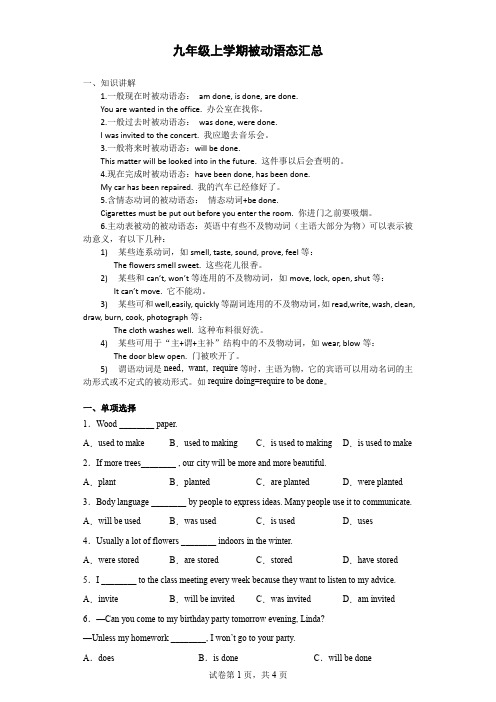
九年级上学期被动语态汇总一、知识讲解1.一般现在时被动语态:am done, is done, are done.You are wanted in the office. 办公室在找你。
2.一般过去时被动语态:was done, were done.I was invited to the concert. 我应邀去音乐会。
3.一般将来时被动语态:will be done.This matter will be looked into in the future. 这件事以后会查明的。
4.现在完成时被动语态:have been done, has been done.My car has been repaired. 我的汽车已经修好了。
5.含情态动词的被动语态:情态动词+be done.Cigarettes must be put out before you enter the room. 你进门之前要吸烟。
6.主动表被动的被动语态:英语中有些不及物动词(主语大部分为物)可以表示被动意义,有以下几种:1)某些连系动词,如smell, taste, sound, prove, feel等:The flowers smell sweet. 这些花儿很香。
2)某些和can’t, won’t等连用的不及物动词,如move, lock, open, shut等:It can’t move. 它不能动。
3)某些可和well,easily, quickly等副词连用的不及物动词,如read,write, wash, clean, draw, burn, cook, photograph等:The cloth washes well. 这种布料很好洗。
4)某些可用于“主+谓+主补”结构中的不及物动词,如wear, blow等:The door blew open. 门被吹开了。
5)谓语动词是need,want,require等时,主语为物,它的宾语可以用动名词的主动形式或不定式的被动形式。
九年级英语被动语态

被动语态结构一般现在时:am / is / are +及物动词的过去分词You are wanted on the phone. 有你的电话。
一般过去时:was / were +及物动词的过去分词China was liberated in 1949.1949年中国解放。
一般将来时:will / shall be +及物动词的过去分词The problem will be discussed tomorrow.明天将对这个问题进行讨论。
现在完成时:have / has been +及物动词的过去分词Not a book in the library has been taken away.图书馆里没有一本书被人拿走。
现在进行时:am / is / are being +及物动词的过去分词My bike is being repaired. 我的自行车正在修理。
过去完成时:had been +及物动词的过去分词The book had been borrowed when I got to the library.我到了图书馆时,那本书已经借出去了。
二、主动语态与被动语态的转换1)把主动语态的宾语变为被动语态的主语。
2)把谓语变为被动结构(be+过去分词)注意:根据被动语态句子里的主语的人称和数,以及原来主动语态句子中动词的时态来决定be的形式。
3)把主动语态中的主语放在介词by之后作宾语,将主格改为宾格。
All the people laughed at him. 所有人都嘲笑他。
→He was laughed at by all people.They make the bikes in the factory. 他们在那家工厂制造自行车。
→ The bikes are made by them in the factory.He cut down a tree. 他砍倒了一棵树。
→ A tree was cut down by him.4)含有情态动词的被动语态含有情态动词的主动句变成被动句时,由“情态动词+be+过去分词”构成。
九年级英语被动语态专项训练
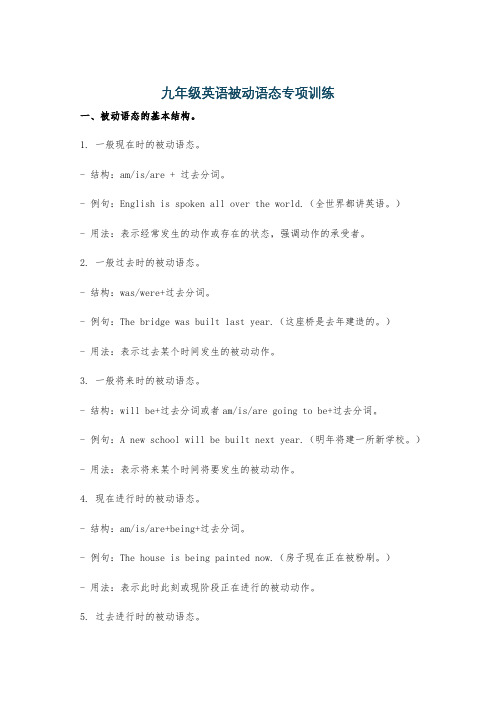
九年级英语被动语态专项训练一、被动语态的基本结构。
1. 一般现在时的被动语态。
- 结构:am/is/are + 过去分词。
- 例句:English is spoken all over the world.(全世界都讲英语。
)- 用法:表示经常发生的动作或存在的状态,强调动作的承受者。
2. 一般过去时的被动语态。
- 结构:was/were+过去分词。
- 例句:The bridge was built last year.(这座桥是去年建造的。
)- 用法:表示过去某个时间发生的被动动作。
3. 一般将来时的被动语态。
- 结构:will be+过去分词或者am/is/are going to be+过去分词。
- 例句:A new school will be built next year.(明年将建一所新学校。
)- 用法:表示将来某个时间将要发生的被动动作。
4. 现在进行时的被动语态。
- 结构:am/is/are+being+过去分词。
- 例句:The house is being painted now.(房子现在正在被粉刷。
)- 用法:表示此时此刻或现阶段正在进行的被动动作。
5. 过去进行时的被动语态。
- 结构:was/were+being+过去分词。
- 例句:When I called him, the work was being done.(当我给他打电话时,工作正在被做。
)- 用法:表示过去某个时刻或某段时间正在进行的被动动作。
6. 现在完成时的被动语态。
- 结构:have/has+been+过去分词。
- 例句:Many trees have been planted in our school.(我们学校已经种了很多树。
)- 用法:表示过去发生的动作对现在造成的影响或结果,强调动作的承受者。
二、被动语态的用法。
1. 不知道动作的执行者是谁?- 例如:My bike was stolen yesterday.(我的自行车昨天被偷了。
初三的英语被动语态详细讲解
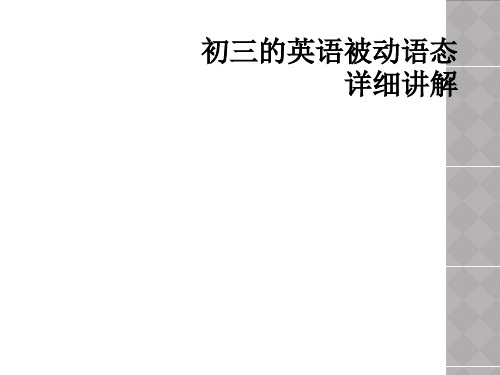
3. 当此动词表示事物的自然属性的时候:
•The pen _________ (write) vewrryitfeasst.
•This kind of sweater _______ (sell) well.
sells
变被动语态:
1 . He tells us a story every evening . We are told a story by him every evening . A story is told to us by him every evening .
主
谓
宾(受动者)
Bowls every day.
are washed
by his brother
2. They bought ten computers last term.
Ten computers were bought (by them) last term. 一般过去时:S+was/were +过去分词
S + will+be+过去分词.
1.一般现在时 am/is/are +done
• We clean the classroom every day. • The classroom is cleaned by us every day.
返回
2.一般过去时 was/were+done
He made the kite. The kite was made by him.
11. I won’t write to my grandpa this evening . My grandpa won’t be written to this evening by me .
九年级被动语态知识点总结
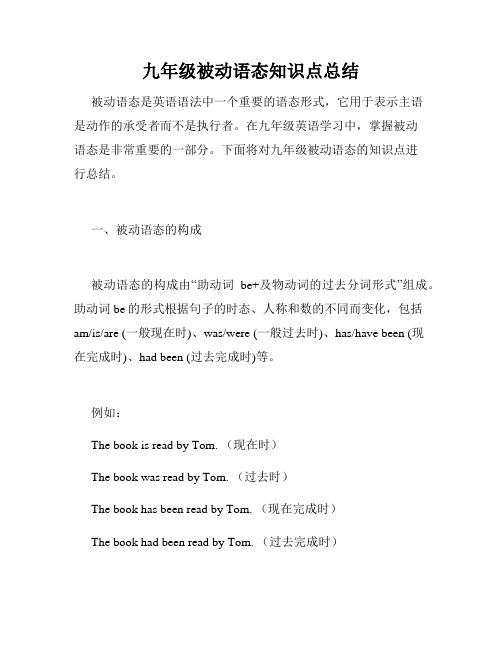
九年级被动语态知识点总结被动语态是英语语法中一个重要的语态形式,它用于表示主语是动作的承受者而不是执行者。
在九年级英语学习中,掌握被动语态是非常重要的一部分。
下面将对九年级被动语态的知识点进行总结。
一、被动语态的构成被动语态的构成由“助动词be+及物动词的过去分词形式”组成。
助动词be的形式根据句子的时态、人称和数的不同而变化,包括am/is/are (一般现在时)、was/were (一般过去时)、has/have been (现在完成时)、had been (过去完成时)等。
例如:The book is read by Tom. (现在时)The book was read by Tom. (过去时)The book has been read by Tom. (现在完成时)The book had been read by Tom. (过去完成时)二、被动语态的用法1. 强调动作的承受者或对象更重要时,常常使用被动语态。
例如:The cake was made by my mother. (强调动作的执行者是“我的妈妈”)The movie will be watched by millions of people.(强调动作的承受者是“数百万人”)2. 当我们不知道或不关心动作的执行者时,可以使用被动语态。
例如:The window was broken.(我们不知道是谁打破了窗户)The car was stolen.(我们不关心偷车的人是谁)3. 由于某种原因或出于某种需要,我们需要隐藏动作执行者的身份时,可以使用被动语态。
例如:The decision has been made.(出于某种原因,我们不想透露决策的执行者)三、使用被动语态时需要注意的问题1. 当动词为不及物动词时,无法使用被动语态。
例如:They sleep on the big bed. (不可以说:The big bed is slept by them.)2. 当动词为感官动词(如see, hear, watch等)时,构成被动语态时需要注意动词后面的介词。
初三英语语法知识点被动语态

初三英语语法知识点:被动语态英语有两种语态:主动语态和被动语态主动语态(The Active Voice)表示主语是动作的执行者。
被动语态(The Passive Voice)表示主语是动作的承受者。
构成:承受者+助动词be+及物动词的过去分词+by+执行者一般现在时:承受者+助动词am / is/are +及物动词的过去分词+by+执行者一般过去时:承受者+助动词was / were +及物动词的过去分词+by+执行者承受者+助动词shall / will be+及物动词的过去分词+by+执行者承受者+助动词 have/ has been+及物动词的过去分词+by+执行者承受者+ can /may/must/should +be+及物动词的过去分词+by+执行者被动语态用法:1)当我们不知道动作的执行者是谁,或者没有必要指出动作的执行者时,需用被动语态。
2)当我们需要强调动作的承受者时,常用被动语态。
3)如果需要说出动作的执行者, 用by引导出动作的执行者。
主动语态变为被动语态时,其谓语动词的时态要与原句时态保持一致,其谓语动词的数要与新主语保持一致。
主动语态变为被动语态时有以下几种情况:1)主语+谓语动词+宾语将主动语态的宾语变为被动语态的主语。
(主动)We bought a book yesterday.(被动)The book was bought yesterday.2)主语+谓语动词+间接宾语+直接宾语将主动语态中一个宾语变为被动语态的主语。
多数情况下将间接宾语变为主语。
如果直接宾语变为主语时,间接宾语前要加介词to / for。
(主动)He showed me a book yesterday.(被动)I was showed a book yesterday.(被动)The book was showed to me yesterday.3)主语+谓语动词+复合宾语含有一个由宾语加宾语补足语构成的复合宾语,变为被动语态时,将主动语态的宾语变为被动语态的主语,宾语补足语保留不变,成为主语补足语。
初三英语(被动语态)
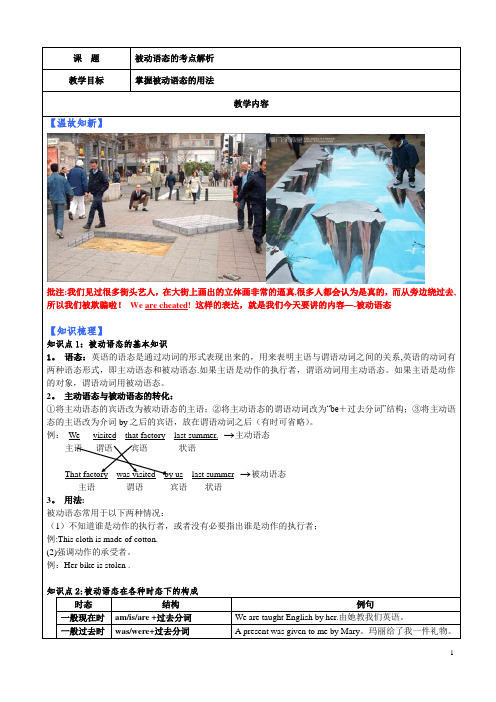
课题被动语态的考点解析教学目标掌握被动语态的用法教学内容【温故知新】批注:我们见过很多街头艺人,在大街上画出的立体画非常的逼真,很多人都会认为是真的,而从旁边绕过去,所以我们被欺骗啦!We are cheated! 这样的表达,就是我们今天要讲的内容—-被动语态【知识梳理】知识点1:被动语态的基本知识1。
语态:英语的语态是通过动词的形式表现出来的,用来表明主语与谓语动词之间的关系,英语的动词有两种语态形式,即主动语态和被动语态.如果主语是动作的执行者,谓语动词用主动语态。
如果主语是动作的对象,谓语动词用被动语态。
2。
主动语态与被动语态的转化:①将主动语态的宾语改为被动语态的主语;②将主动语态的谓语动词改为“be+过去分词”结构;③将主动语态的主语改为介词by之后的宾语,放在谓语动词之后(有时可省略)。
例:We visited that factory last summer. →主动语态主语谓语宾语状语That factory was visited by us last summer →被动语态主语谓语宾语状语3。
用法:被动语态常用于以下两种情况:(1)不知道谁是动作的执行者,或者没有必要指出谁是动作的执行者;例:This cloth is made of cotton.(2)强调动作的承受者。
例:Her bike is stolen .知识点2:被动语态在各种时态下的构成时态结构例句一般现在时am/is/are +过去分词We are taught English by her.由她教我们英语。
一般过去时was/were+过去分词 A present was given to me by Mary。
玛丽给了我一件礼物。
A。
must give B. must be give C. must be given D. must be gave解析:答案C.考查情态动词的被动语态。
它每天必须被喂食,应用被动语态,其构成是be+过去分词,故选C。
中考中的被动语态知识点总结与归纳

中考中的被动语态知识点总结与归纳被动语态是英语语法中一个重要的知识点,也是中考英语考试中常见的题型。
理解和掌握被动语态的用法对于学生来说至关重要。
本文将对中考中的被动语态知识点进行总结和归纳,帮助学生全面了解和掌握该知识点。
一、被动语态的构成和用法被动语态的构成:主语+be动词(根据时态变化)+过去分词被动语态的用法:1. 当我们不知道或不想提及动作的执行者时。
例句:The car was stolen last night.(昨晚这辆车被偷了。
)2. 当我们想强调动作的承受者时。
例句:The book was written by a famous author.(这本书是一位著名作家写的。
)3. 当我们想表达客观事实时。
例句:The Great Wall was built in the Qin Dynasty.(长城始建于秦朝。
)二、被动语态的各种时态1. 一般现在时的被动语态构成:am/is/are + 过去分词例句:The letter is written in English.(这封信用英语写的。
)2. 一般过去时的被动语态构成:was/were + 过去分词例句:The cake was eaten by the children.(蛋糕被孩子们吃掉了。
)3. 一般将来时的被动语态构成:will be + 过去分词例句:The meeting will be held next Monday.(会议将在下周一举行。
)4. 现在进行时的被动语态构成:am/is/are being + 过去分词例句:The house is being built at the moment.(这座房子正在建造中。
)5. 过去进行时的被动语态构成:was/were being + 过去分词例句:The car was being repaired when I arrived.(当我到达时,汽车正在修理中。
初三知识点总结被动语态
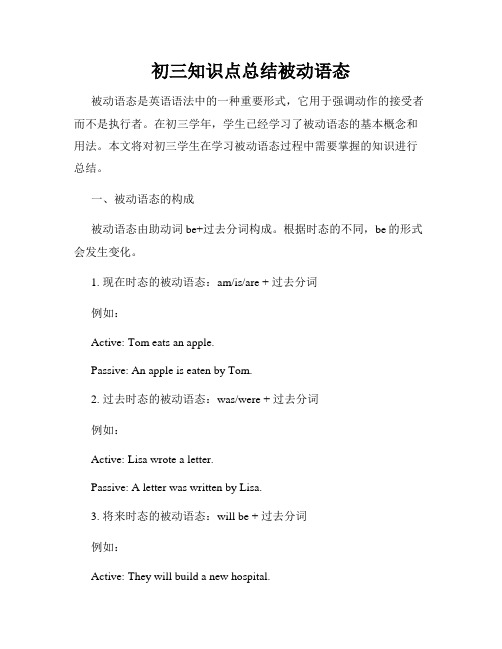
初三知识点总结被动语态被动语态是英语语法中的一种重要形式,它用于强调动作的接受者而不是执行者。
在初三学年,学生已经学习了被动语态的基本概念和用法。
本文将对初三学生在学习被动语态过程中需要掌握的知识进行总结。
一、被动语态的构成被动语态由助动词be+过去分词构成。
根据时态的不同,be的形式会发生变化。
1. 现在时态的被动语态:am/is/are + 过去分词例如:Active: Tom eats an apple.Passive: An apple is eaten by Tom.2. 过去时态的被动语态:was/were + 过去分词例如:Active: Lisa wrote a letter.Passive: A letter was written by Lisa.3. 将来时态的被动语态:will be + 过去分词例如:Active: They will build a new hospital.Passive: A new hospital will be built by them.二、主动语态和被动语态的转换在学习被动语态时,初三学生需要学会主动语态和被动语态的相互转换。
具体转换规则如下:1. 直接宾语转换:将主动语态中的直接宾语变为被动语态中的主语。
例如:Active: They eat apples.Passive: Apples are eaten by them.2. 双宾语转换:将主动语态中的间接宾语变为被动语态中的主语,直接宾语变为介词by短语。
例如:Active: He gave me a book.Passive: I was given a book by him.3. 无宾语动词转换:将主动语态中的无宾语动词转换为被动语态时,需加上介词by和动词的进行时态。
例如:Active: They swim in the pool.Passive: The pool is being swum in by them.三、被动语态的用法被动语态在英语中有多种用途,以下是初三学生应掌握的主要用法:1. 主动语态的被动表达:当我们不知道或不关心动作的执行者时,可以使用被动语态。
初三英语被动语态小结(Be+done)及练习含部分答案
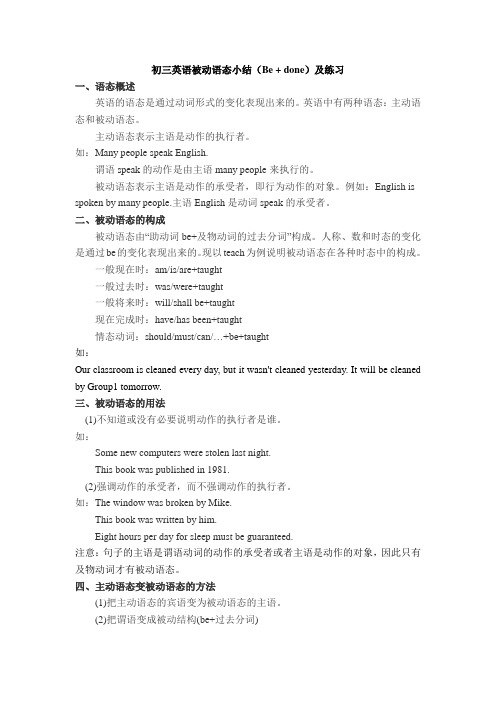
初三英语被动语态小结(Be + done)及练习一、语态概述英语的语态是通过动词形式的变化表现出来的。
英语中有两种语态:主动语态和被动语态。
主动语态表示主语是动作的执行者。
如:Many people speak English.谓语speak的动作是由主语many people来执行的。
被动语态表示主语是动作的承受者,即行为动作的对象。
例如:English is spoken by many people.主语English是动词speak的承受者。
二、被动语态的构成被动语态由“助动词be+及物动词的过去分词”构成。
人称、数和时态的变化是通过be的变化表现出来的。
现以teach为例说明被动语态在各种时态中的构成。
一般现在时:am/is/are+taught一般过去时:was/were+taught一般将来时:will/shall be+taught现在完成时:have/has been+taught情态动词:should/must/can/…+be+taught如:Our classroom is cleaned every day, but it wasn't cleaned yesterday. It will be cleaned by Group1 tomorrow.三、被动语态的用法(1)不知道或没有必要说明动作的执行者是谁。
如:Some new computers were stolen last night.This book was published in 1981.(2)强调动作的承受者,而不强调动作的执行者。
如:The window was broken by Mike.This book was written by him.Eight hours per day for sleep must be guaranteed.注意:句子的主语是谓语动词的动作的承受者或者主语是动作的对象,因此只有及物动词才有被动语态。
初三英语被动语态知识点整理
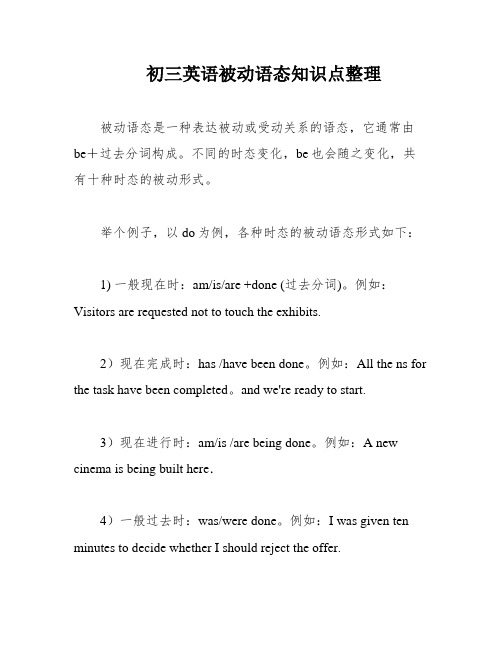
初三英语被动语态知识点整理被动语态是一种表达被动或受动关系的语态,它通常由be+过去分词构成。
不同的时态变化,be也会随之变化,共有十种时态的被动形式。
举个例子,以do为例,各种时态的被动语态形式如下:1) 一般现在时:am/is/are +done (过去分词)。
例如:Visitors are requested not to touch the exhibits.2)现在完成时:has /have been done。
例如:All the ns for the task have been completed。
and we're ready to start.3)现在进行时:am/is /are being done。
例如:A new cinema is being built here.4)一般过去时:was/were done。
例如:I was given ten minutes to decide whether I should reject the offer.5)过去完成时:had been done。
例如:By the end of last year。
another new XXX.6)过去进行时:was/were being done。
例如:A meeting was being held when I was there.7)一般将来时:shall/will be done。
例如:Hundreds of jobs will be lost if the factory closes.8)过去将来时:should/would be done。
例如:The news would be sent to the XXX it arrived.9)将来完成时(少用):shall/will have been done。
例如:The project will have been XXX.此外,被动语态还有一种特殊结构形式,即带情态动词的被动结构。
初中九年级英语(被动语态)

We should take care of the old. The old should be taken care of by us.
3. 含有双宾语的主动句变被动句时,可将主动句中的直 接宾语或间接宾语变为被动句中的主语。 如果把主动句中的直接宾语(指物)变为被动句中的主语, 则需在间接宾语(指人)前加适当的介词to或for。 常接to的动词有give, tell, lend, show, pass, hand等; 常接for的动词有buy, get等。
四、被动语态结构中应注意的几个问题 1. 主动句中在感官动词see、hear、watch、feel、notice等
以及使役动词let、make、have等后跟省略to的不定式, 变为被动句时, 应加上不定式符号to。
Someone saw a stranger walk into the building. A stranger was seen to walk into the building.
被动语态
一、被动语态的构成 被动语态是由“be +动词的过去分词”构成的。 助动词be随着主语的人称、数和时态的不同而变 化。
三、使用被动语态的情况 1. 不知道动作的执行者是谁。 My book is stolen. 2. 没有必要指出动作的执行者是谁。 Many trees are planted in our school every year. 3. 需要强调或突出动作的承受者时。 I was given ten minutes to decide whether I should accept the offer. 4. 有些动词习惯上常用被动语态。 It’s said that.... it’s reported that.... it’s well know that...
- 1、下载文档前请自行甄别文档内容的完整性,平台不提供额外的编辑、内容补充、找答案等附加服务。
- 2、"仅部分预览"的文档,不可在线预览部分如存在完整性等问题,可反馈申请退款(可完整预览的文档不适用该条件!)。
- 3、如文档侵犯您的权益,请联系客服反馈,我们会尽快为您处理(人工客服工作时间:9:00-18:30)。
动词的语态动词的语态用以说明句中主语和谓语的关系。
如果主语是动作的执行者,动词形式为主动语态;如果主语是动作的承受者,动词形式为被动语态。
被动语态与主动语态一样,也是中考的重要考点之一,分值约占中考总分值的8%。
考查的内容主要有被动语态的用法、被动语态的结构、被动语态与主动语态的相互转化、不能使用被动语态的句型等。
考查的形式包括用所给的动词的适当形式填空、单项选择、句型转换、完型填空、阅读理解等。
1.被动语态的构成被动语态和主动语态一样,也有各种时态形式,其基本结构是,be+过去分词。
被动语态的谓语和主语在逻辑上是动宾关系。
初中阶段常见的几种时态的被动语态:(1)一般现在时:am/is /are+过去分词History is made by people.历史是由人民创造的。
(2)一般过去时:was/were+过去分词The book was written by him.这本书是他写的。
The radio wasn’t mended last week.上周这台收音机没被修理。
(3)一般将来时:a. am/is/are going to be+过去分词;b.will/shall be +过去分词。
Some trees will be planted this spring.今年春天将要植一些树。
Shall we be asked to study English?会不会要我们去学英语?(4)含有情态动词的被动语态:情态动词+be+过去分词The man must be sent to hospital.这个人必须被送往医院。
(5)现在进行时:am/is/are+being+过去分词Some trees are being planted by the students.Is a few factory eing built in your village?(6)现在完成时:have/has been +过去分词She is unhappy because she hasn’t been asked to the party.她不高兴,因为她没有被邀请去参加聚会。
被动语态的基本用法:(1)不知道动作的执行者是谁,或没有必要指出动作的执行者时用被动语态。
Letters are collected at eight every morning.信件每天早上八点收取。
The glass was broken last night.玻璃被打坏了。
(2)为了强调或突出动作的承受者时。
例如:The plan has already been made.计划已经制定好了。
The bag was taken away by his sister.那个包被他姐姐拿走了。
(3)在上下文中,为了使句子衔接更紧密(结构的需要)时要用被动语态。
I have a new bike. It was given to me as a birthdaypresent by my father.我有一辆新自行车。
它是父亲作为生日礼物送给我的。
(3)在新闻报道或科技论文中,常用被动语态来表示客观事实。
A car accident happened on the highway this morning.Three man were killed,the wounded were taken away to the hospital at once and policeman were sent there to cope with the event.今天早上高速公路发生一起车祸。
三人丧生,伤者被马上送往医院,并派了警察去处理这一事件。
被动语态使用中应注意的问题1.主动语态变为被动语态的方法。
a.宾语→主语:把主动语态的宾语变为被动语态的主语。
例如:这个国家人们说法语。
People speak French in the country.他在打一份报告She is typing a report.A report is being typed by her.2.主语谓语→被动谓语:be 动词要按新主语的人称和数作变化,谓语由主动结构变为被动结构。
例如:The repairman is fixing the ovens.修理工在修理炉子。
The ovens are being fixed (by the repairman).炉子在修理中。
警察已经抓住了小偷。
小偷已经被抓。
My sister took good care of me.我姐姐很好的照顾我。
I was taken good care of(by my sister)我被(姐姐)照顾得很好。
3.把主动语态的主语,改为‘by+原主语’放在主谓结构之后。
在意思明确时by短语可以省略。
如:We speak English.English is spoken by us.(2)含有双宾语是句子有主动语态变为被动语态时有两种情况。
①把间接宾语改为被动语态的主语,直接宾语留在原位。
②把直接宾语改为被动语态的主语。
此时,间接宾语前要加介词“to ”和“ for”.例如:He gave the boy an apple.他给男孩一个苹果。
The boy was given an apple(by him).An apple was given to the boy.(3)若动词短语为不可分割的整体,短语中的介词不能省略。
1.We must take good care of the young trees.The young tress must be taken good care of.2.You must pay attention to the problem.The problem must be paid attention to.(4)感官动词或使役性动词在主动语态中与省略“to” 的动词不定式连用,但变为被动语态的时候,必须还原“to”I often hear her sing in the next room.She is often heard to sing in the next room.(5)‘主+谓+宾语+宾语补足语’只将主动语态中宾语变为被动语态的主语。
宾语补足语不变。
We should keep our school clean and tidy.我们应该保持学校的干净和整洁。
Our school should be kept clean and tidy.I find him in bad health.我发现他身体很差。
He was found in bad health.主动形式表被动意义的情况①表示主语内在特性的动词,如:read, write, wash, sell cut, open, clean等常与副词well, easily, smoothly 等连用。
The pen writes well.The books sell well.②连系动词:一“be”一“出现”(appear)三“保持”(stay, remain, keep)四“起来”(look,smell, sound, taste)五“变成”(become, get, grow, fall, turn)还有“好像”(seem)和“感觉”(feel)这些词加上形容词表被动。
例: The food tastes delicious.这个是我尝起来很好吃。
The soup smells great. 这个汤闻起来真棒。
③动词need, require, want, deserve后接Ving 的主动结构表被动意义。
The car needs cleaning.你的车需要洗了。
Your hair needs cutting.你的头发需要剪了。
④有些动词,如cook,print等,常用主动结构表被动意义。
The lunch is cooking.不用被动语态的五种情况(1)谓语为连系动词时不用被动语态。
He looks fine.他看起来气色很好。
The material feels soft.这个材料摸起来感觉很柔软。
(2)谓语为不及物动词(短语),如appear, fail, happen, fall asleep break out, die, end, last, remain, sit, come true, take place, lie.不能用被动语态。
The war broke out in the end. 战争最终爆发了。
I happened to meet him there.我碰巧在那遇见他。
(3)宾语为动词不定式,动词的ing 形式或从句,表示主语的一些想法,爱好,或愿望时,一般不用被动语态。
He decided to go with us.他决定和我们一起去。
She likes to swim.她喜欢游泳。
(4)宾语是相互代词,反身代词,同源宾语时等,一般不用被动语态。
We should help each other.我们应该互相帮助。
He thinks of himself too much.他为自己考虑得太多。
(5)宾语表示处所,地点时,一般不用被动语态。
We will reach the station in two hours.我们两小时内将到达车站。
He has gone to London.他已经去伦敦。
点击中考一.选择题(真题回放)1.He fall of the tree.A. was seen toB. was seenC. saw toD. saw2.An accident last night.A. was happenedB. happenedC. happensD. is happened.3.Great changes in our city since 19e 80.A. took placeB. have taken placeC. were taken placeD. have been taken place.4.Students to close the windows before they leave the physics and chemistry lab.A. tellB. will be toldC. was invitingD. invited5.Many students in Sichuan to shanghai to study last year.A. be sent B are sent C. were sent D. have been sent6.Thanksgiving Day on the fourth Thursday in November in the U.S every year.A.is celebratedB. was celebratedC. will celebratedD.is celebrating7.This was the first time David to join in an out-of-school activity.A. askedB. was askedC.asksD.is asked8.It is almost known to all that the Olympics Games every four years.A. holdB.is heldC.holdsD.are held9.The foreign guests around our city by our school bus this afternoon.A.will be shownB.will showC.would be shownD.would show10.Finally,the big serious forest fire by the firemen yesterday.A.puts outB.had put outC.was put outD.has put out11.More monkey to protect the environment next year.esB.is usedC.will useD.will be used12.Do you think this shirt real silk?A.is made ofB.is made fromC.is made up ofD.is made into13.The newspaper says that more money fighting pollution next year.A.will spendB.will be spentC.would spendD.would be spent14.The fire out by firemen in that building an hour ago.A. was putB. putsC. is puttingD. is put15.A candidate for the post at the moment.A.is interviewingB.being interviewingC.interviewingD.is being interviewed二.用所给词的适当形式填空。
